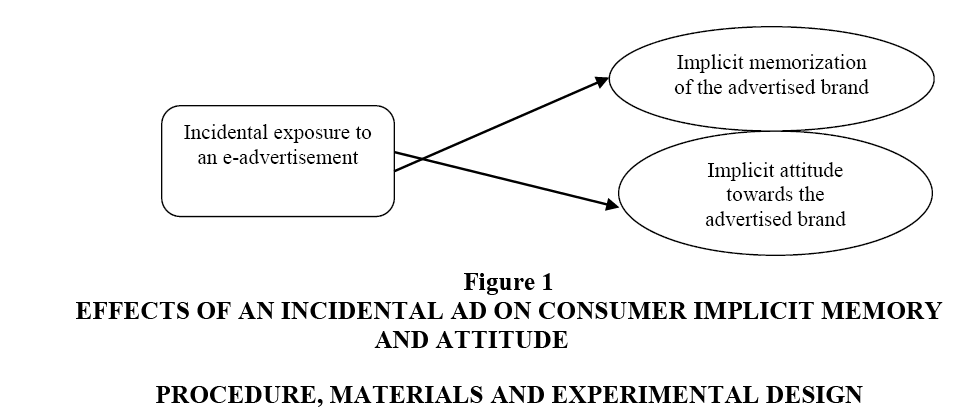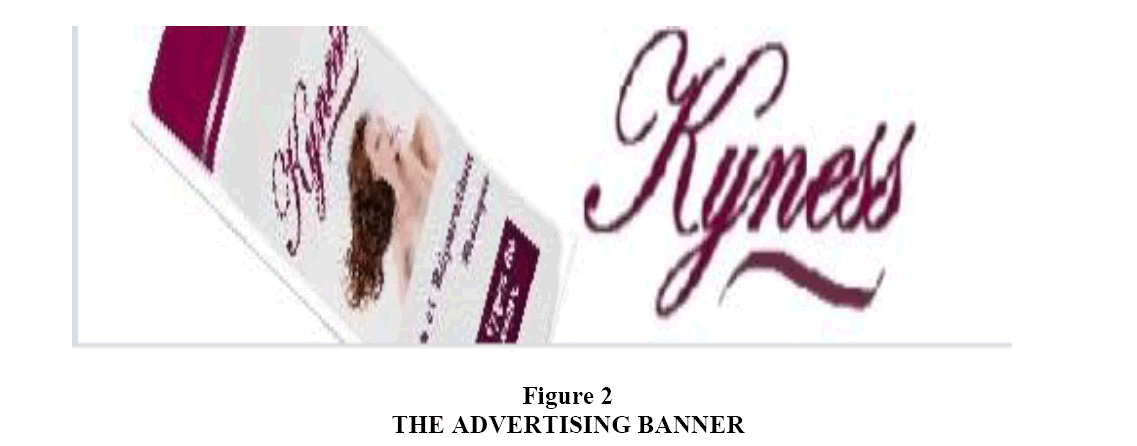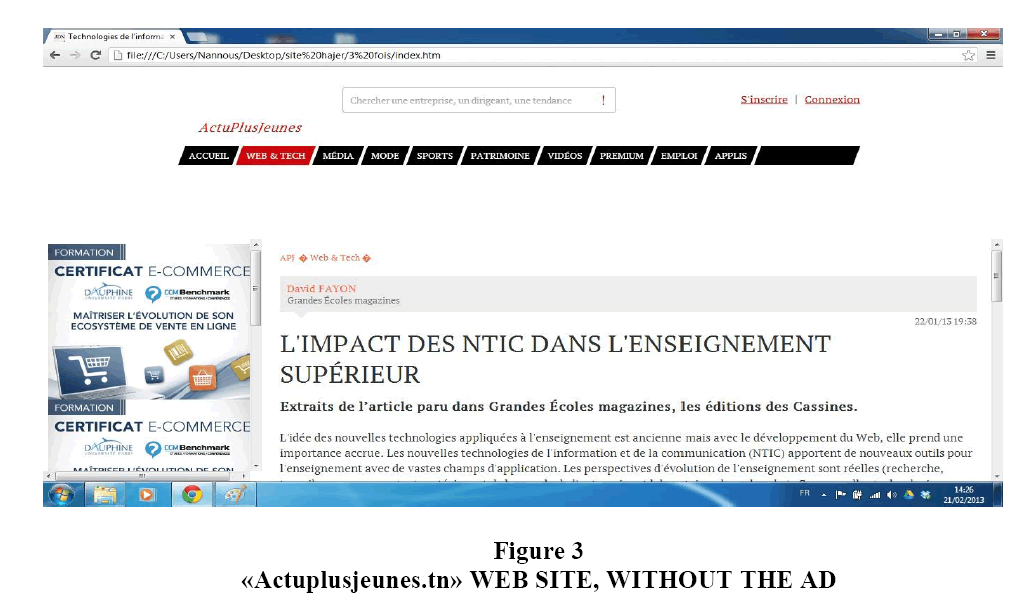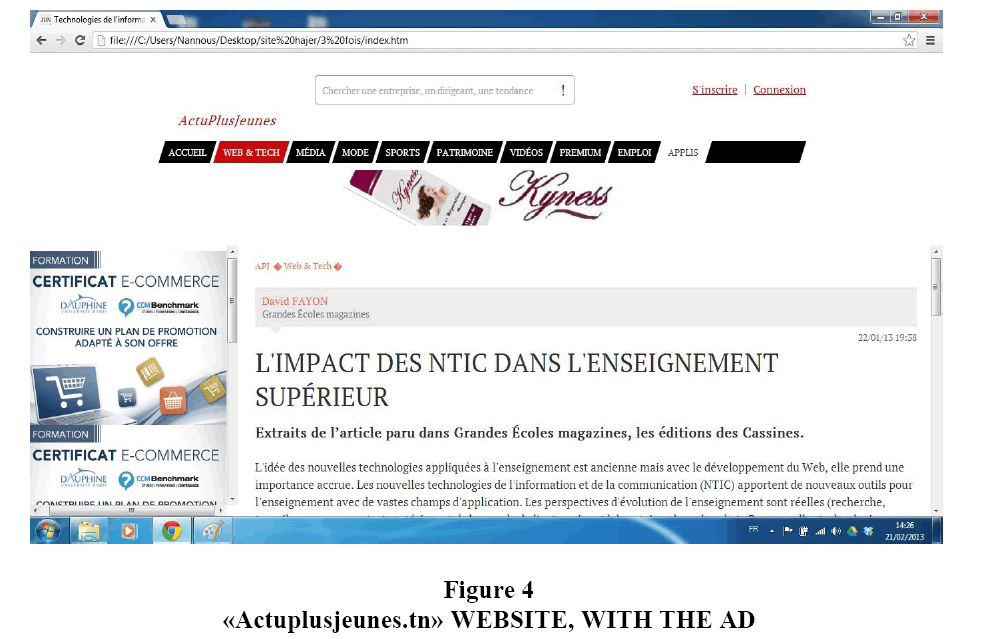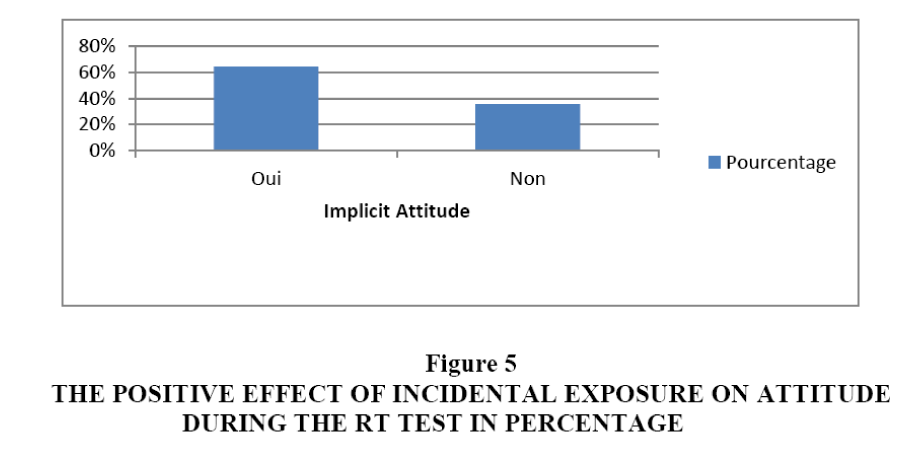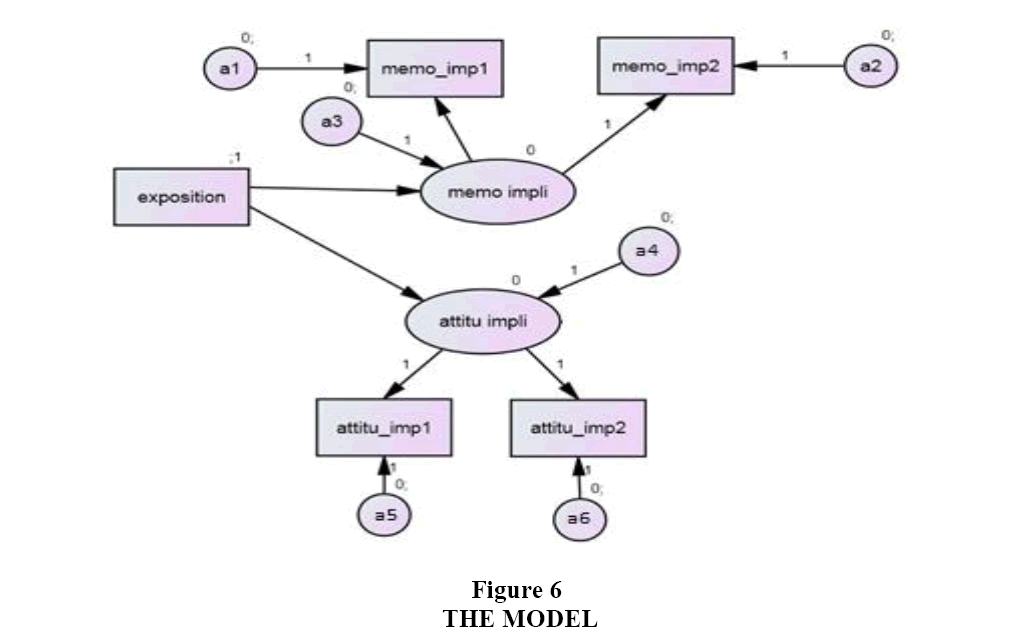Original Articles: 2017 Vol: 21 Issue: 2
Implicit Effects of Online Advertising on Consumer Cognitive Processes
Hager Machouche, University of Tunis
Abderrazek Gharbi, University of Tunis
Chokri Elfidha, University of Tunis
Abstract
The aim of this paper is to better understand consumer implicit cognition and to contribute to the enlargement of ad efficiency measurement methods. Specifically, we try to measure the effects of an ad stimulus on automatic information memorizing processes as well as on consumer attitudes. To this end, we set up an implicit effects protocol, using the Reaction Time measurement method, a method that fits perfectly well a study of the fundamental implicit social cognition mechanisms and is known for generating obsjective and accurate observable results. The results of our experiment showed that an incidental exposure to an ad banner allows for forming an implicit positive attitude towards the advertised brand. Moreover, we found that an incidental exposure to an ad allows not only for the memorization of the advertised brand into implicit memory but also triggers its implicit positive assessment that activates, spontaneously, the advertised brand in memory.
Keywords
Incidental Advertising, Implicit Cognition, Implicit Measure of Reaction Time (RT), Marketing, Consumer Behavior.
Introduction
Understanding consumer behavior and studying the mental information process that consumers undergo to interact with their environment are among the most fundamental objectives of marketing researches. Different disciplines, like psychology, computer science or neurosciences, showed that such a cognitive approach offers an unexpected opportunity to further the research into the specific cognitive modes that organize and manage our life, in particular the unsuspected power of the implicit character of these processes. Indeed, researches in social and cognitive psychology introduced a new stream of research that focused on the concept of "implicit cognition". This latter includes, among other concepts, the notions of implicit memory (Graf & Schacter, 1985) and implicit attitude (Greenwald & Banaji, 1995), two concepts that have begun to catch the interest of researchers of consumer behavior over the last fifteen years.
Janiszewski (1988), a pioneer of this new field, supported that ads have an unconscious effect on consumer behavior. The author succeeded in showing that a simple exposure to a brand name or to a packaging may lead the consumer to adopt a more positive attitude towards the brand even when the consumer does not recall having been exposed to any advertising stimulus. These implicit effects of advertising on attitude were mostly branded under the label incidental exposure (Janiszewski, 1993). The author argues that formation of attitudes towards brands/products are not uniquely the product of conscious mental processing, but rather they result from a parallel processing of commercial information by means of pre-attentive and automatic processes, on the one hand, and by conscious and reflective processes, on the other (Janiszewski, 1988 & 1990).
Research Model, Objectives and Hypotheses
As stated by Courbet & Fourquet (2003) and Trendel & Warlop (2005), the unconscious effect of advertising is made through two main channels. The first denotes the unconscious effects of a consciously encoded advertising message, whose effects are unconscious (Lee, 2002; Strick et al., 2009). The second implies, from the outset, an unconscious encoding of advertising by the consumer, when for example, the stimulus is subliminally presented (Droulers, 2000) or when consumers are incidentally exposed to an advertising message (Shapiro, 1999; Janiszewski, 1993; Droulers, 2001; Courbet et al., 2003; Yoo, 2009).
In our study, we will focus on the latter. Specifically, we examine the implicit effects of incidental advertising (perceived without conscious attention) on consumer cognitive processes, in particular underlying the mechanisms of memorization and information processing.
Then, our aim is to contribute to enlarge the marketing literature on the implicit memory- and attitude-related processes, notably by using a measurement method, exclusively employed by cognitive science. Moreover, this study highlights the increasingly useful use of implicit measurement methods of consumer cognition in very specific advertising exposure contexts. Therefore, it is important to test the effects of an online advertisement on consumers’ implicit memorization and attitude. This medium is one of the best frameworks to study the implicit effects of advertising in a context of incidental exposure. Indeed, Internet users are generally focused on a specific task and engage very little cognitive resources towards e-advertising.
This type of ads is considered uninteresting and consumers are highly likely to avoid it along with the multiple and ceaseless advertising pop ups present on a web page. This behavior of Internet users does not prevent these stimuli from being, nevertheless, perceived at a pre-attentive stage and integrated into consumers’ cognitive processes (Drèze & Hussherr, 2003; Droulers, 2001, Courbet et al., 2003; Yoo, 2007).
We recall that incidental stimuli to which an individual is exposed are perceived and memorized, and their assessment and preferences can also be improved, even in the absence of any recollection of the encoding episode (Zajonc, 1968).
The state of the art literature on the effects of mere exposure to online advertising indicates that most of these ads, to which consumers pay little or no attention at all, are retained in memory through implicit processes and therefore, they affect consumers' attitudes and behavior towards the brands presented in these ads (Yoo, 2007 & 2009; Courbet et al., 2008b; Mitchell & Valenzuela, 2005).
According to Janiszewski (1993), any exposure "which, due to lack of attention, does not result in an awareness of exposure" can be described as incidental. For Courbet et al. (2008a), "a few brief exposures to a publicity processed with low attention are enough to form a cognitively fluid representation of the brand in memory". Shapiro et al. (1997) argue, for example, that incidental exposure to an advertisement of any brand allows the brand to upgrade in the set of products referred to, whatever the product category is. This concept of implicit memory can be defined as "unintentional, automatic and unconscious retrieval of information previously stored in memory, without a direct reference to the exposure stage or the information stored itself" (Herrmann et al., 2011). This explicit memory is thus revealed when the fulfillment of a task requires the conscious recollection of past experiences and expresses itself in behavior (Westen & Garitte, 2000). In order to probe information contained in this memory, researchers in cognitive psychology mainly use indirect introspection methods called "implicit measurements of memory restitution" (Trendel & Warlop, 2005).
The studies of Courbet et al. (2008a), Yoo (2008) and Hansen & Wänke (2009) have all shown that incidental exposure to advertising can influence not only memorization of brands in implicit memory but also implicit attitude. Implicit attitude is defined by Greenwald & Banaji (1995) as "traces of past experience, neither identified by nor attributed to introspection, which emotionally differentiate and mediate present thoughts, feelings and judgments of social objects". The authors further add that they are "a powerful determinant of behavior when they are weakly implicated". Thus, there are implicit attitudes when an individual has "particular attitudes unaware of them" and "when these attitudes have no explanation immediately available to the subject" (Smeralda, 2011). Courbet & Fourquet (2003) conclude that "in contact with an object, this type of attitude is activated much more rapidly than explicit attitude is, outside the subject’s consciousness". It is Fazio et al. (1986) who were the first to show that attitudes can be activated automatically from memory following the simple presentation of the to-be-evaluated object.
Implicit attitude is presented as a construct that is automatically activated from implicit memory when the to-be-evaluated object is presented (Courbet & Fourquet-Courbet, 2005; Bargh & Apsley, 2001; Fitzsimons et al., 2002). Then, in addition to implicit memorization of the advertised brand, incidental exposure to an advertisement will make it possible to form implicit evaluation of it, which will raise positive attitudes towards it. These attitudes are activated almost immediately as soon as the brand in question is perceived (Briggs & Hollis, 1997; Pêtre, 2005; Vanhuele, 1999; Droulers, 2001; Yoo, 2008; Hansen & Wänke, 2009) (Figure 1).
Figure 1: Effects of an Incidental Ad on Consumer Implicit Memory and Attitude Procedure, Materials and Experimental Design
Bearing on the previous research, we formulate the following research hypotheses:
H1 An incidental exposure to an online advertising banner of a fictitious brand activates an implicit memorization of the brand in question.
H2 Incidental exposure to an advertising banner generates an implicit (positive) attitude towards the advertised brand.
Data Collection Method
To measure unconscious psychological constructs, it is essential to use an indirect measurement method. Many measures of implicit cognition have been developed. Most of them aim at measuring the facilitating role of prior exposure to a stimulus in performing one or more subsequent tasks, without reference to the encoding episode. Unconscious cognitive processes are then inferred from an "increased performance" of the experimental group compared to the control group (Shacter, 1987). It is thus the measurement of this facilitating effect that will be the implicit test (Richardson-Klavehn & Bjork, 1988). In our experiment, the "facilitating effect" will be measured by recording reaction time (RT). This latter method uses protocols to measure latency of participants' responses through a computerized system. This method measures to the nearest thousandth of a second the lapse of time used up before each response.
The reasons to choose the reaction time method to measure variables representing consumer implicit cognition are twofold:
• It is a tool that fits perfectly a study of the fundamental properties of implicit social cognition (Greenwald & Banaji, 1995). In fact, it makes it possible to determine the presence of implicit psychological constructs, whatever their nature (perceptual, memorial or attitudinal), which perfectly suits our research model.
• Reaction Time (RT) is currently considered the best indicator of the implicit dimension of attitudes (Fazio, 2000).
Procedure
Following the literature on implicit tests (e.g. Tulving, 1995), our experimental procedure is divided into three stages:
Stage 1
We invite subjects to participate in a "fake" study. We informed them that the study is conducted by the Tunisian Ministry of Higher Education and Scientific Research to determine students’ opinions about using new information and communication technologies in higher Education. They are asked to consult a web site (in which the advertising for the fictitious brand will be inserted or not, depending on the group), and to read a text about the studied topic (Courbet et al., 2008b). A questionnaire is then used to check the "reliability of the experimental design" (Courbet et al., 2008b).
Stage 2
Five minutes later, subjects are asked to participate in a second survey, with a totally different focus. This study tests new branded products before their real marketing by their company. Subjects were informed not to link the two surveys. This is the test phase (recording the dependent variables representing implicit cognition).
Stage 3
The first step is to check the reliability of the experimental protocol testing the implicit effects of advertising as recommended by Tulving (1995). This is usually done by checking recall and recognition rates (explicit) of the new brand using a post-experiment questionnaire and then retaining only the subjects who are unable to recall the brand as well as the context of its exposure. Second, the results obtained from the exposed participants will be compared with those of the control group who were not exposed to the new brand during the first stage of the experiment.
The post-experiment questionnaire includes statements about brand recall and recognition and/or its advertising as a way to remove from the sample those participants who remember the exposure or one of its elements.
Instruments
In order to measure implicit memory and attitude effects of e-advertising of the new brand after incidental exposure, we designed the following instruments:
• The professional website.
• Designing a brand and its logotype, in line with the recommendations of Pêtre (2005) and Courbet et al. (2004). Importantly, this step ensures that the participants will be exclusively exposed and for the first time to the website and the presented brand and therefore avoids the risk of them being previously exposed to it.
• Designing advertising banners for the product of the new brand.
We opted for a "Shampoo" product with the brand name Kynessi the brand name; its design and the shampoo bottle were conceived in a way that they should attract most participants. Indeed, the affective valence of the perceived advertising message is known to affect consumers’ implicit cognitive and behavioral responses. Therefore, an unpleasant advertising message will likely to be judged, memorized and automatically associated with negative affective valences in consumers’ minds, while an incidental exposure to pleasant logotypes or brands positively support their implicit assessments and judgments by consumers (Gawronski & Bodenhausen, 2006; Lee & Labroo, 2004; Courbet et al., 2000 & 2003).
According to Yoo (2009), dynamic advertising banners offer a higher likelihoo of internalizing the advertised brand in the subject's implicit attentional and perceptual process. Therefore, we designed a standard (468 × 60 pixels) size animated banner for the fictional brand "Kyness", using the "E-anime" software (Figure 2):
The advertising banner will be inserted in an online information site targeting young students, named "Actuplusjeunes.tn". We designed the web site for the purposes of our experiment. Below are two screen shots of the web site. The first is the version without the ad of the fictional "Kyness" shampoo brand and the second is the version with the ad (Figures 3 and 4):
Moreover, according to Janiszewski (1988 & 1993) and Shapiro et al. (1997), designing a protocol measuring the implicit effects of incidentally perceived advertising needs to meet the following criteria:
• The stimulus (in our case, the advertising banner) should not be a central focus (diagnostic or symbolic) for the subject.
• The stimulus must be maintained discreet, i.e., the subject should not be aware of the presence of the advertising banner on the website.
In order to meet these guidelines, the "Kyness" advertising banner was placed at the top side of the screen above the text to be read. In addition, we asked subjects to focus their attention on the text and prevent themselves from being distracted, as they will be asked some questions after the experiment. According to Krishnan & Chakravarti (2003), such instructions are enough to design an experimental protocol to measure the effects of ads placed outside a focal area.
The Sample
Because we believe that participants’ profiles will not intervene with our hypotheses testing, we opted for a student’s-oriented convenience sampling method. Indeed, our choice of an exclusively students sample is justified by two constraints:
• Our experimental methodology, consisting of three phases (exposure to the website, recording RTs, administering a questionnaire about brand recall and recognition), needed the use of internet-accessing computer rooms connected to a local network.
• Our sample should consist of people who know how to use a computer.
Therefore, we targeted undergraduate and postgraduate students taking a computer science course at the Higher Institute of Human Sciences in Tunis. Overall, 184 subjects participated in our experiment.
Measurement Implicit Cognition Variables
Consumer implicit cognition variables will be operationalized by RTs analysis (TR). The procedure as presented by Courbet et al. (2004) is as follows: the questions should be asked using a computer. A computerized program automatically develops the questionnaire and records the answers "yes" or "no" and the time the participants took to answer the questions (RT is the time span between the appearance of the question on the screen, and a participant’s pressing one of the two mouse buttons corresponding to either "yes" or "no"). The subjects were clearly instructed and reminded to respond to each item as quickly and accurately as possible (Fazio, 1990).
Our dependent variables therefore are the "yes" or "no" responses and the time elapsed to respond to the following items:
Item Measuring the Implicit Memorization of the 'Kyness' Brand
"You will successively see three new brands, even if you do not know one, say if one or more of them seem familiar to you".
This question is relevant because it allows us to determine implicit memory traces of the new brand in the exposed participants through the perceptive fluidity mechanism. This mechanism defines the facilitating effect generated by a previous incidental exposure while processing the brand (Lee & Labroo, 2004). Through this mechanism, exposed participants process more easily and quickly information about the brand than unexposed participants. They should judge spontaneously and automatically the fictitious brand as being "familiar" to them (Vanhuele, 1999).
Item Measuring the Implicit Attitude towards the Kyness Brand
"Without knowing the category of products they market, say if you like these new brands."
Implicit attitudes are "traces of past experience, neither identified by nor attributed to introspection, which affectively polarize and mediate present thoughts, feelings and judgments about social objects" (Greenwald & Banaji, 1995). We will only measure the emotional dimension of implicit attitude. Because we want to encourage responses representing only affective assessments of the brand, no reference should be made to the category of products marketed by the brand in question (Courbet et al., 2004).
Because individuals form implicit attitudes towards an object using traces of an object stored in their implicit memory (Bargh & Apsley, 2001), the time individuals with memory traces take to evaluate an object will then be shorter than individuals without implicit memory traces. Therefore, people who have implicitly memorized the "Kyness" brand will respond faster than people who have not been exposed to the brand.
Experimental Design and Data Collection
Experimental Design
The 184 students who agreed to participate in our experiment were randomly assigned to one of two experimental conditions:
First Group (Control Group) (G1=61)
The students assigned to this group should login to the "actuplusjeunes.tn" web site and read the text. They should not be exposed to any ad of the 'Kyness' brand; they only participate then in the second phase of the experiment, RT recording and analysis.
Second Group (Subjects Exposed to Advertising) (G2=123)
The subjects assigned to this group read the text on the "actuplusjeunes.tn" web site with the ad of the "Kyness" brand. The advertising banner is programmed to appear on the web site only one time and to last for 4 s. Then, the participants in this group take the RT test and next answer the questions on the ad and/or brand recall and recognition.
Data Collection
The data were collected from a sample of 184 students studying at the Higher Institute of Human Sciences in Tunis, during their weekly computer science course.
Data on implicit cognition were collected using the RT method using the TR-lab software, a software specially designed and developed for the purposes of our experiment by the company "A & Z DEV”ii In addition, the data collection procedure was tested in advance with some 20 students in order to ensure that the procedure and the content of the experimental protocol will be well understood by the participants.
Data Processing and Hypothesis Testing
Purification of RTs Data
By the end of our survey, we eliminated data from students who declared that they recognize the "Kyness" brand and/or have seen the advertising banner. We retained only the subjects who answered negatively to all the questions on the explicit memorization and recall of the context of exposure. We eliminated observations from students who responded to the RT test before the "Kyness" logo appeared on the screen leading to inappropriate RTs<100 ms. Moreover, we rounded all RTs>4 s at 4000 ms as recommended by Fazio (1990). The distribution of our final sample, after data purification is as follows:
• G1 (Control group): n=61.
• G2 (Group exposed to advertising): n=106.
Hypotheses Testing
Research in socio-cognitive psychology that used the RTR method most often uses analysis of variance (ANOVA). Accordingly, we used ANOVA to test our two hypotheses on the implicit character of cognition as operationalized by the RT test.
As mentioned above, determining implicit cognitive processes amounts to measuring a facilitating effect that is more visible in the experimental group than in the control group (Richardson-Klavehn & Bjork, 1988). In our study, RTs should reveal this facilitating effect. Indeed, according to Courbet et al. (2004 & 2008a), the implicit effects of an incidental exposure are not observed on the verbal responses of the subjects (in our case, the "yes" and "no" category responses that will be the same whatever the experimental condition, but by analyzing the RTs of the exposed individuals against the RTs of the unexposed subjects.
H1 An incidental exposure to an Internet advertising banner for a fictitious brand activates an implicit memorization of the brand in question.
By analyzing the "Yes" RTs to the question "Tell us if the Kyness brand seems familiar to you", we notice that the participants exposed to the advertising banner of the "Kyness" brand responded faster than the participants of the first group (who have not been exposed to the banner). We compared the means of the "yes" RTs of the control group to those of the experimental group. The following Table 1 summarizes the main results obtained from the ANOVA analysis:
| Table 1 Means of Rt "Yes" By Groups to the Item "The Kyness Brand is Familiar to Me" |
||
| YES | «YES» RTS | |
| Groups | N | m (SD) |
| Control Group | 29 | 2109 (1162) |
| Experimental Group | 48 | 1544 (1042) |
RT "yes": Reaction time for "yes" in "ms"; N=Number; M=Mean; SD=Standard Deviation
We found that the mean of RT "yes" in the experimental group is significantly lower than that of the control group: 1544 ms against 2109 ms, with p=0.023. Thus, participants exposed, incidentally, to the ad of the "Kyness" brand, have indeed implicitly memorized the brand; they took less time than the unexposed participants to answer "yes" to the item on implicit memorization. The first hypothesis is thus retained.
H2 Incidental exposure to the advertising banner activates an implicit (positive) attitude towards the advertised brand.
We will begin by testing the positive effect of incidental exposure to the advertising banner on attitude towards the brand. By comparing those who exhibited a positive attitude towards the brand to those who expressed a negative attitude towards it during the RT test, we found that the percentage of those who favor the brand (64.4%) is higher than that of those who are unfavorable (35.6%). The t-Student test on a single sample shows a statistically significant difference between the "yes" and "no" groups at p=0.000. The following Figure 5 and Table 2 summarize the main results:
| Table 2 T-Test Results on a Single Sample, "Implicit Attitude" |
|||
| VALUE OF t=0 | |||
| t | Df | Sig. | |
| Implicit Attitude | 22,936 | 291 | 0.000 |
Incidental exposure to advertising has therefore allowed the formation of a positive attitude towards the advertised brand.
To examine the implicit character of attitude, we will proceed to compare the means of "yes" and "no" responses of the control group to this item with those of the experimental group. The main ANOVA results are reported below (Table 3):
| Table 3 Means of "Yes" And "No" According to Groups to the Item "I like the Kyness Brand" |
||||
| YES | RT «YES» | NO | RT «NO» | |
| Groups | n | m (SD) | n | m (SD) |
| Control Group | 32 | 2024 (1041) |
29 | 2131 (977) |
| Experimental Group | 69 | 1445 (1141) |
34 | 1515 (992) |
RT "yes": Reaction time for "yes" in "ms"; RT "no": Reaction time for "no" in "ms"; N=Number; M=Mean; SD=Standard Deviation
Analyzing the "yes" RTs, we notice that the mean "yes" of the control group (2024 ms) is significantly higher than the mean "yes" of the experimental group (1445 ms), p=0.011. The analysis of the "no" TRs indicates that the mean RT of the control group (2131 ms) is also significantly higher than the mean RT of the experimental group (1515 ms), p=0.017.
Participants who were exposed to the "Kyness" brand ad responded faster than those who have not been exposed to the ad.
We can, therefore, conclude that incidental exposure to the advertising banner affects the formation of an implicit positive attitude towards the advertised brand, thus hypothesis H2 is retained.
Following the ANOVA analysis, we proceed to a structural equation modeling, using the AMOS software. Let us first note that since we cannot construct latent variables with a single indicator, the variables "exposure”iii and "purchase_intent", corresponding, respectively, to incidental exposure to the advertising banner and the "Intention to purchase the Kyness product", will be included in our model as observable variables.
In the following Table 4, the latent variables and their observable labels are presented:
| Table 4 Definition of Latent Variables |
|
| The latent variable | Observable labels |
| memo impli | memo_imp1 |
| memo_imp2 | |
| attitu impli | attitu_imp1 |
| attitu_imp2 | |
Validation of the Structural Model
To validate our model, we chose to conduct a confirmatory factor analysis (CFA)iv. CFA is possible since with a 3-item construct the model is said to be "exactly identified", making our estimation practical. The obtained results confirm the reliability of the measurement scale of attitude with a Jöreskog ρ=0.870 and its convergent validity with a ρvc=0.692. Below, the graph formalizes the causal structure between the different variables of the model:
Fit quality of our model is assessed by means of fit indicesv (Figure 6 and Table 5).
With regard to absolute fit indices, the results are satisfactory with GFI and AGFI greater than 0.9; RMSEA is 0.109 whereas, ideally, this value should not exceed 0.08. However, this result can be qualified as an acceptable limit.
Parsimony indices also seem to be satisfactory with a standardized chi-square of 5.181. This value is certainly greater than 3, but it remains within acceptable limits. The measurement model seems to be parsimonious, in particular with the BIC and CAIC indices lower than those of the saturated model.
Examining the standardized regression coefficients, we found that all the tested relationships are significant (p<0.5). Indeed, observing the relationship between the variables "exposure" and "memo impli", we found a weak positive relationship (β=0.052), hypothesis H1 is thus retained, which is consistent with the ANOVA results and which clearly indicates the positive effect of incidental exposure to advertising on the implicit memorization of the brand. Moreover, the positive effect of incidental exposure on implicit attitude towards the brand has been validated (β=0.332), hence hypothesis H2 is retained.
Conclusion
In this study, we found a facilitating effect of incidental exposure to an advertising banner of the "Kyness" brand on the implicit memorization of the brand as well as the implicit positive attitude towards it.
This finding supports our theoretical assumptions about the notion of implicit memory as an "unintentional, automatic and unconscious recovery of neither information previously stored in memory without a direct reference to neither the exposure context nor information itself (Herrmann et al., 2011). We confirm also the theory on the effects of mere exposure and the results on incidentally perceived memorization of advertising messages found by Janiszewski (1993), Shapiro & Krishnan (2001), Yoo (2008) or by Courbet et al. (2008b).
As for implicit attitude, our results do indicate that implicit attitudes are "traces" of an experience that cannot be determined by introspection and which nevertheless affects our evaluation of an object. Moreover, our results are consistent with those obtained by previous studies, indicating that incidental exposure to an ad not only allows for memorizing an advertised brand in implicit memory but also allows for a positive implicit attitude towards the brand being activated spontaneously as soon as the brand is presented (Vanhuele, 1999; Droulers 2001; Shapiro & Krishnan, 2001; Lee, 2001; Courbet et al., 2008a; Yoo, 2008; Hansen & Wänke, 2009).
This study contributes to a better understanding of implicit memory and attitudinal processes, their importance to consumer cognitive processes, and the integration of their unconscious effects measurement into the measurement methodology of efficient advertising communication. In addition, this study helps to better understand the functioning of implicit memory and its effects by evaluating the weight and role of unconscious memory traces of an advertising banner of a fictitious shampoo brand in forming attitudes towards the brand in question, in a context of incidental media communication.
From a methodological point of view, through the implementation of a thorough experimental approach, we have been able to show that an incidental exposure to an online advertising banner of a fictitious brand allows for both the unconscious memorization of the brand and the formation of implicit positive attitudes towards it. Moreover, extrapolating the RT measurement method (usually reserved for research in socio-cognitive psychology) into consumer behavior research to determine the implicit effects of advertising communication allowed us to conduct an empirical, accurate and objective evaluation of unconscious advertising efficiency.
Indeed, in addition to the traditional qualitative methods of investigation, usually used in the field of consumer behavior and aimed essentially at identifying unconscious associations in the mind of the consumer, this work proposes a new mode of operation To marketing practitioners, which can be used in addition to these methods and which contributes to palliate the subjectivity of the results generally observed with them.
Endnote
I. To ensure a reliable experimental protocol, two other fictitious shampoo brands and their logos are designed. They are «Rouzy» and «Fanna».
II. A company specialized in designing and developing computer programs and applications.
III. To test our model, we constructed the variable «exposure» that takes 1 for exposed subjects and 0 for unexposed subjects.
IV. Multinormality of the variables «attitu_expli1», «attitu_expli2» and «attitu_expli3» has been set before proceeding to CFA by checking «Skewness» and «Kurtosis», a distribution is considered normal if |Skewness|<1 and |Kurtosis|<1.5. |Skewness| attitu_expli1=0.361 et |Kurtosis| attitu_expli1=0.049; |Skewness| attitu_expli2=0.091 et |Kurtosis| attitu_expli2=0.299; |Skewness| attitu_expli3=0.133 et |Kurtosis|attitu_expli3=0.333.
V. We chose not to use incremental indices. Indeed, the obtained results with these indices will likely not be conclusive given the specificity of the tested model, in particular the presence of two latent variables out of 3 («memo impli» and «attitu impli» ) estimated and measured by two items each.
- Bargh, J.A. & Apsley, D.K. (2001). Unraveling the complexities of social life. American Psychological Association.
- Briggs, R. & Hollis, N. (1997). Advertising on the web: Is there response before click-through? Journal of Advertising Research, 37(2), 33-45.
- Courbet, D. & Fourquet, M.P. (2003). La télévision et ses influences, DeBoeck.
- Courbet, D. & Fourquet-Courbet, M.P. (2005). Modèles et mesures de l’influence de la communication: Nouvelles perspectives ouvertes par la psychologie sociale. Revue Internationale de Psychosociologie, 11(25), 7-26.
- Courbet, D. (2000). Les effets automatiques du parrainage télévisuel sur la marque : étude de la mésattribution de la familiarité du transfert sémantique et de l’influence des émotions déclenchés par le programme. Recherche et Applications en Marketing, 15(1), 39-62.
- Courbet, D. (2003). L’influence publicitaire en l’absence de souvenir des messages: Les effets implicites de la simple exposition. Cahiers Internationaux de Psychologie Sociale, 3(57), 39-51.
- Courbet, D., Intartaglia, J., Borde, A. & Denis. S. (2004). L’influence non consciente des publicités vues furtivement et aussitôt oubliées: Une méthode d’étude socio-cognitive appliquée à internet. Questions de Communications, 5, 83-102.
- Courbet, D., Van Huele, M. & Lavigne, F. (2008). Les effets persuasifs de l’e-publicité perçue «sans conscience» en vision périphérique. Implications pour les recherches sur la réception des médias. Questions de Communication, 14, 197-219.
- Courbet, D., Fourquet-Courbet, M.P. & Intartaglia, J. (2008). Publicité sur Internet: que reste-t-il des mots, que reste-t-il des images, trois mois après en mémoire implicite? Revue des Interactions Humaines Médiatisés, 9(1), 1-24.
- Drèze, X. & Hussherr, F. (2003). Internet advertising: Is anybody watching? Journal of Interactive Marketing, 17(4), 8-21.
- Droulers, O. (2000). Perception subliminale: Une expérimentation sur le processus d’activation sémantique des marques. Recherche et Applications en Marketing, 15(4), 43-59.
- Droulers, O. (2001). Publicité incidente et commerce électronique: une proposition d’expérimentation. Acte du IVème colloque Etienne Thil.
- Fazio, R.H. (1990). Multiple processes by which attitudes guide behavior: The MODE model as an integrative framework. Advances in Experimental Social Psychology, 23, 75-109.
- Fazio, R.H. (2000). Accessible attitudes as tools for object appraisal: Their costs and benefits. In Maio G.R. & Olson J.M., Why we evaluate: Functions of attitudes. Ed. Routledge.
- Fazio, R.H., Sanbonmatsu, D.M., Powell. M.C. & Kardes. F.R. (1986). On the automatic activation of attitudes. Journal of Personality and Social Psychology, 50(2), 229-238.
- Fitzsimons, G.J., Hutchinson, J.W., Williams, P., Alba, J.W., Chartrand, T.L., Huber, J., Kardes, F.R., Menon, G., Raghubi, P., Russo, J.E., Shiv. B. & Tavassoli. N.T. (2002). Non-conscious influences on consumer choice. Marketing Letters, 13(3), 269-279.
- Gawronski, B. & Bodenhausen, G.V. (2006). Associative and propositional processes in evaluation: An integrative review of implicit and explicit attitude change. Psychological Bulletin, 132(5), 692-731.
- Graf, P. & Schacter, D.A. (1985). Implicit and explicit memory for new associations in normal and amnesic subjects. Journal of Experimental Psychology: Learning Memory and Cognition, 11(3), 501-518.
- Greenwald, A.G. & Banaji, M.R. (1995). Implicit social cognition: Attitudes, self-esteem and stereotypes. Psychological Review, 102(1), 4-27.
- Hansen, J. & Wânke. M. (2009). Liking what’s familiar: The importance of unconscious familiarity in the mere-exposure effect. Social Cognition, 27(2), 161-182.
- Herrman, J.L., Walliser, B. & Kacha, M. (2011). Le contrôle des effets du parrainage sur l’audience: L’intérêt des mesures implicites de restitution mémorielle. Décisions Marketing, 62, 7-18.
- Janiszewski, C. (1988). Preconscious processing effect. Journal of Consumer Research, 15(2), 199-209.
- Janiszewski, C. (1993). Pre-attentive mere exposure effects. Journal of Consumer Research, 20(3), 376-392.
- Krishnan, H.S. & Chakravarti, D. (2003). A process analysis of the effects of humorous advertising executions on brand claims memory. Journal of Consumer Psychology, 13(3), 230-245.
- Lee, A.Y. & Labroo, A.A. (2004). The effect of conceptual and Perceptual fluency on brand evaluation. Journal of Marketing Research, 41(2), 151-165.
- Lee, A.Y. (2001). The mere exposure effect: An uncertainty reduction explanation revisited. The Society for Personality and Social Psychology, 27(10), 1255-1266.
- Lee, A.Y. (2002). Effect of implicit memory on memory-based versus stimulus-based brand choice. Journal of Research in Marketing, 39(4), 440-454.
- Mitchell, A. & Valenzuela, A. (2005). How banner ads affect brand choice without click-through. In: Haugtveldt C.P., Machlait K.A. & Yalch R.F., Online Consumer Psychology, Ed. Lawrence Erlbaum Associates.
- Petre, A. (2005). Mémorisation non consciente des publicités: Apport d’une mesure implicite dans une application au netvertising. Revue Française de Marketing, 201, 23-48.
- Richardson-Klavehn, A. & Bjork, R. (1988). Measures of memory. Annual Review of Psychology, 39, 475-543.
- Shapiro, S. (1999). When an ad’s influence is beyond our conscious control: Perceptual and conceptual fluency effects caused by incidental ad exposure. Journal of Consumer Research, 26(1), 16-36.
- Shapiro S., Heckler, E. & Macinnis, S. (1997). Measuring and assessing the impact of pre-attentive processing on an ad and brand attitude. In Wells D.W. Measuring advertising effectiveness, Ed. Lawrence Erlbaum Associates.
- Strick, M., Van Barren, R.B., Holland, R.W. & Knippenberg, A.V. (2009). Humor in advertisements enhances product liking by mere association. Journal of Experimental Psychology: Applied, 15(1), 35-45.
- Trendel, O. & Warlop, L. (2005). Présentation et applications des mesures implicites de restitution mémorielle en marketing. Recherche et Applications en Marketing, 20(2), 77-104.
- Tulving, E. (1995). Organization of memory: Quovadis? In M.S. Gazzaniga, The cognitive neurosciences, Ed. The MIT Press.
- Vanhuele, M. (1999). Les effets de la publicité ambiante. L’Art du Marketing, Les Echos, Ed.
- Westen, D. & Garitte, C. (2000). Psychologie: pensée, cerveau et culture. DeBoeck.
- Yoo, C.Y. (2008). Unconscious processing of web advertising: Effects on implicit memory, attitude toward the brand consideration set. Journal of Interactive Marketing, 22(2), 2-18.
- Yoo, C.Y. (2009). Effects beyond click-through: Incidental exposure to web advertising. Journal of Marketing Communications, 15(4), 227-246.
- Zajonc, R. (1968). Attitudinal effects of mere exposure. Journal of Personality and Social Psychology, 9(2), 1-27.
